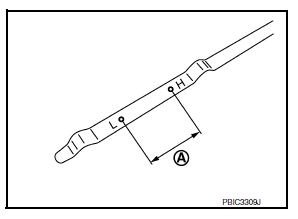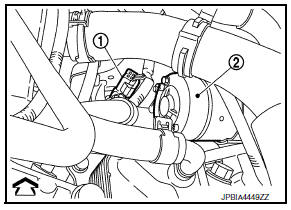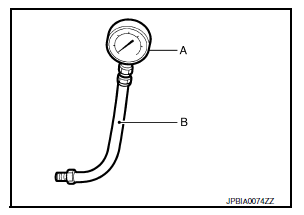Nissan Sentra Service Manual: Engine oil
Inspection
Engine oil level
Note:
Before starting engine, put vehicle horizontally and check the engine oil level. If engine is already started, stop it and allow 10 minutes before checking.
- Pull out oil level gauge and wipe it clean.
- Insert oil level gauge and check that the engine oil level is within the range (A) shown.
- If engine oil is out of range, adjust it.

ENGINE OIL APPEARANCE
- Check engine oil for white turbidity or heavy contamination
- If engine oil becomes turbid and white, it is highly probable that it is
contaminated with engine coolant.
Repair or replace damaged parts.
ENGINE OIL LEAKAGE
Check for engine oil leaks around the following areas.
- Oil cooler
- Oil temperature sensor
- Oil pan (upper and lower)
- Oil pan drain plug
- Oil pressure sensor
- Oil filter
- Valve timing control cover
- Valve timing control solenoid valve (intake and exhaust)
- Front cover
- Mating surface between cylinder head and camshaft bracket
- Mating surface between cylinder block and cylinder head
- Mating surface between camshaft bracket and rocker cover
- Crankshaft oil seals (front and rear)
OIL PRESSURE CHECK
WARNING:
- Be careful not to get burned, as engine oil may be hot.
- When checking engine oil pressure, shift position should be “P” (CVT models) or “N” (M/T models), and apply parking brake securely.
- Check engine oil level.
- Disconnect harness connector at oil pressure sensor (1), and remove oil pressure sensor using a suitable tool.
(2) : Starter motor
CAUTION:
Do not drop or shock oil pressure sensor.

- Install Tools (A) and (B).
Tool number (A) : ST25051001 (J-25695-1)
Tool number (B) : ST25052000 (J-25695-2)

- Start engine and warm it up to normal operating temperature.
- Check engine oil pressure with engine running under no-load.
NOTE:
When engine oil temperature is low, engine oil pressure becomes high.
Engine oil pressure : Refer to LU-17, "Oil Pressure".
CAUTION:
If difference is extreme, check oil passage and oil pump for oil leaks.
- After the inspections, install oil pressure sensor as follows:
- Remove old liquid gasket adhering to oil pressure sensor and engine.
- Apply liquid gasket and tighten oil pressure sensor to specification.
Use Genuine RTV Silicon Sealant or equivalent.
Tightening torque : Refer to EM-94, "Exploded View".
- Check engine oil level.
- After warming up engine, check that there are no leaks of engine oil with engine running.
Draining
WARNING:
-
Be careful not to get burned, as engine oil may be hot.
-
Prolonged and repeated contact with used engine oil may cause skin cancer. Try to avoid direct skin contact with used engine oil. If skin contact is made, wash thoroughly with soap or hand cleaner as soon as possible.
- Warm up the engine, and check for engine oil leaks from engine components. Refer to LU-7, "Inspection".
- Stop the engine and wait for 10 minutes.
- Loosen oil filler cap.
- Remove drain plug and then drain engine oil.
Refilling
- Install drain plug with new drain plug washer. Refer to EM-33, "Exploded View".
CAUTION:
Be sure to clean drain plug and install with new drain plug washer.
Tightening torque : 34.3 NВ·m (3.5 kg-m, 25 ft-lb).
- Refill with new engine oil.
- Engine oil specification and viscosity: Refer to MA-11, "Engine Oil Recommendation".
- • Engine oil capacity : Refer to LU-17, "Oil Capacity".
CAUTION:
- The refill capacity depends on the engine oil temperature and drain time. Use these specifications for reference only.
- Always use oil level gauge to determine the proper amount of engine oil in the engine.
- Warm up engine and check area around drain plug and oil filter for engine oil leaks.
- Stop engine and wait for 10 minutes.
- Check the engine oil level. Refer to LU-7, "Inspection".
 Oil filter
Oil filter
Removal and Installation
REMOVAL
Remove engine under cover. Refer to EXT-16, "Exploded View".
Drain engine oil. Refer to LU-8, "Draining".
Remove the oil filter using Too ...
Other materials:
Windshield wiper and washer switch
Switch operation
Type A
Type B
The windshield wiper and washer operates when
the ignition switch is placed in the ON position.
Push the lever down to operate the wiper at the
following speed:
Intermittent (INT) — intermittent operation
can be adjusted by turning the knob A .
Lo ...
M&a branch line circuit
Diagnosis procedure
1.Check connector
Turn the ignition switch off.
Disconnect the battery cable from the negative terminal.
Check the terminals and connectors of the combination meter for damage,
bend and loose connection
(unit side and connector side).
Is the inspection result nor ...
Standardized relay
Description
Normal open, normal closed and mixed type relays
Relays can mainly be divided into three types: normal open, normal closed and
mixed type relays.
Type of standardized relays
...

